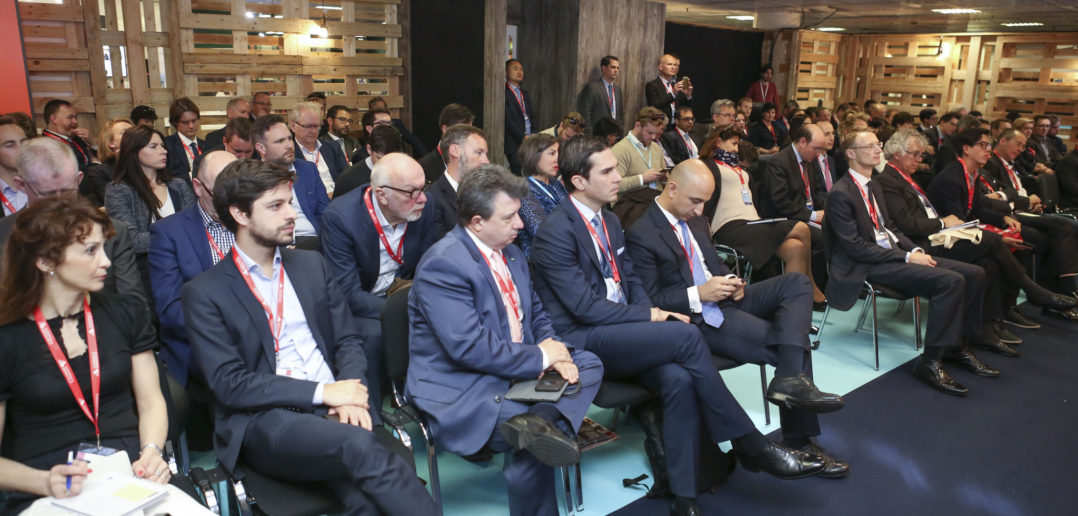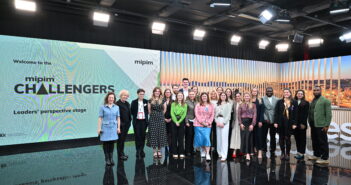The session on disruptive technologies impacts, sponsored by Autodesk, was standing room only, clearly indicative of the growing interest in technology among real estate professionals.
Panelists:
- Emmanuel Di Giacomo, D.P.L.G. Architect, BIM Ecosystem Business Development Manager, Autodesk
- Gregoire Viasnoff, Marketing Director, Schneider Electric
- Edward Woods, Chief Technical Officer / Directeur Central Technique, Bouygues Immobilier
- Dominic Thasarathar, Strategist: Construction, Energy, Natural Resources, Autodesk
Dominic Thasarathar articulated how design is being driven by demand. Demands from both the end users and the building development collaboration partners is being met by the power of the cloud. The raw computing potential readily available is facilitating real time simulations of wind models, lifecycle costs and anything else that can be simulated using an algorithm. With this increased computing power comes the expectation that all final designs will be the best, no more trial and error. While humans can provide creative input, it’s the computers that lack bias and are able to deliver clean end results. This structure offers designers with smart algorithms the opportunity to set parameters and design outcomes that meet the given requirements. These digital design files lend themselves to AR (augmented reality) and VR (virtual reality) interaction, prior to, during and after construction. Being able to “suck” the real world into a digital one as a starting point only further accelerates the design process, its detail, and accuracy. Autodesk makes it possible to manage this new era of digital connection and provide an end product that considers the full lifecycle of values.
Next, Edward Woods explained how the physical construction of buildings is becoming more automated. Embracing and incorporating BIM (Building Information Modeling) systems in all designs allows this to be possible, and practical. The physical fabrication gets moved off-site and into a more controlled setting. This reduces error, waste and increases precision. Robots are increasingly being incorporated into the manufacturing process, in particular on mundane tasking. Design and construction risks can be pushed back upstream into the design phase. “Building as a service” becomes the focus of the builder/assembler. As a result, the end product becomes more flexible and modular and complete assembly that used to take months can be reduced to weeks, cutting overall costs.
It’s truly time to “go digital or die.”
Finally, Gregoire detailed the many ways BIM engineered buildings can be operated in ways never seen before. Eco structures have been tracking data for years, but today the sharing and integration of that data is becoming more user friendly. For example, the optimum floor of the parking garage to look for parking in can be feed into your handheld device as you approach. Meeting locations in foreign buildings can be routed to with the push of a button by a visitor in the lobby, no need to seek signage or try to interpret directories. Conference spaces can be located, and once inside the lighting, temperature and shades of the room can be adjusted, all with a mobile device. Even a service order can be placed to building management with the click of a button and then tracked through to completion. A “big baby step” has taken place.
The digital design, construction and operation of buildings is being revolutionised with the advent of the cloud’s computing potential, the power of BIM’s collaborative platform, and mobile interaction of everything digital. But this revolution also presents some challenges. In particular, the IP (intellectual property) and data cybersecurity are both areas of sensitivity and attention. Privacy and transparency are pulling in opposite directions, but the owner ‘owns’ the data. Companies entrusted with the creation and handling of the data through the process take safeguards via confidentiality agreements and other documents, but as the amount of building data continues to grow, there will likely be demand for at least some of it to be sold.
Look for this topic to appear again in next year’s MIPIM as the opportunities and impacts are both only beginning to be realized.



